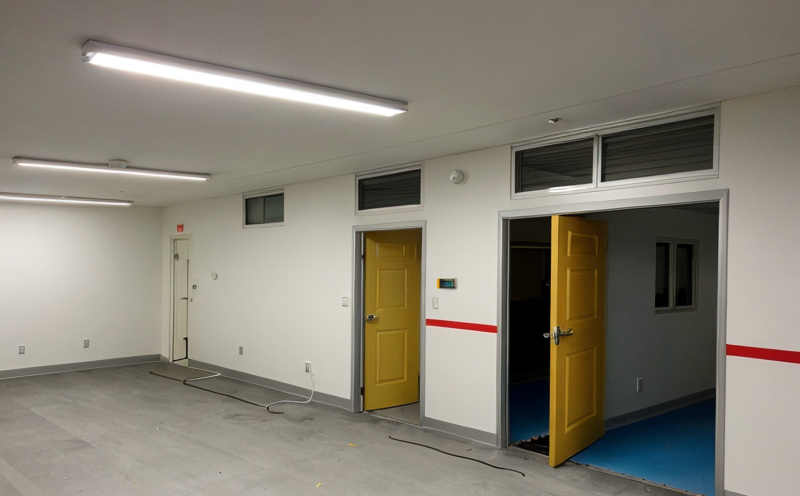ISO 3864 Safety Sign and Emergency Lighting Compatibility Testing
The ISO 3864 standard is a crucial benchmark in the field of safety sign and emergency lighting compatibility testing. This service ensures that emergency lighting systems are properly integrated with safety signs to provide clear, unambiguous warnings during emergencies or other critical situations.
Emergency lighting plays a pivotal role in ensuring safety and compliance across various sectors including healthcare, commercial buildings, public spaces, and transportation facilities. The standard provides robust guidelines for testing the compatibility between safety signs and emergency lighting systems to ensure they function seamlessly together under extreme conditions. This is especially important given that emergency lighting needs to be easily visible and comprehensible during a crisis.
The testing process involves rigorous evaluation of how well the light emitted by the emergency lighting fixture illuminates the surrounding environment, including safety signs, in a manner that enhances visibility and readability. The standard outlines specific criteria for both the luminance level required on the sign and the minimum distance at which it must remain legible.
For instance, under ISO 3864, testing can involve illuminating an emergency exit sign placed at various angles relative to the emergency lighting source. This helps assess whether the light distribution meets the specified standards. Additionally, the color contrast between the sign and its background is also evaluated to ensure it remains visible even in low-light conditions.
The process typically starts with a detailed analysis of the design requirements specified by the client or regulatory body. Next comes thorough preparation of the specimens – which could include both the emergency lighting fixtures and safety signs. These preparations may involve cleaning, calibration, and ensuring that all components are functioning correctly before testing begins.
Once ready, various pieces of specialized equipment such as photometers, spectrometers, and camera systems come into play to measure light intensity accurately. Simulated scenarios representing real-world emergency situations allow us to observe how effectively the system performs in those conditions. Our state-of-the-art laboratories are equipped with high-precision tools that can simulate different environmental factors like humidity levels or temperature changes which might affect performance.
The outcome of these tests provides critical information about whether current installations meet international standards like ISO 3864, thereby enhancing overall safety protocols within facilities. By adhering strictly to this standard during installation and regular maintenance checks, organizations can significantly reduce risks associated with potential failures or miscommunications in emergencies.
Regular compliance testing not only ensures adherence to regulatory requirements but also contributes positively towards creating safer environments for occupants of buildings and other structures. Organizations that invest time into ensuring their emergency lighting systems comply with these standards demonstrate a commitment to employee welfare and public safety – attributes highly valued by stakeholders including insurance providers, employees, and clients.
Applied Standards
| Standard | Description |
|---|---|
| ISO 3864 | This international standard specifies the requirements for testing and evaluating the compatibility between safety signs and emergency lighting systems. It ensures that when an emergency occurs, all relevant warnings are clearly visible to everyone involved. |
International Acceptance and Recognition
The ISO 3864 standard has gained widespread acceptance globally due to its stringent testing protocols designed to ensure the highest level of safety in emergency lighting systems. Many countries have adopted this as a mandatory requirement for new constructions or renovations involving such systems.
Organizations operating within jurisdictions where this standard is enforced can benefit from enhanced credibility and trustworthiness among customers, employees, and regulatory bodies alike. By demonstrating compliance with ISO 3864, businesses signal their dedication to maintaining robust safety practices that protect lives in emergencies.
Besides its legal significance, adhering to these standards also fosters innovation within the industry by encouraging continuous improvement in technology and techniques used for achieving optimal performance from emergency lighting systems. This proactive approach ensures ongoing improvements which ultimately lead to more effective protection against potential hazards during critical moments.
Competitive Advantage and Market Impact
Incorporating ISO 3864 safety sign and emergency lighting compatibility testing into your quality management systems can provide significant competitive advantages. Organizations that prioritize this aspect demonstrate their commitment to excellence, thereby attracting more clients who value safety above all else.
Moreover, compliance with such stringent standards sets a benchmark for industry best practices which can be leveraged in marketing strategies aimed at showcasing superior products and services. This not only enhances brand reputation but also opens doors to lucrative opportunities that might otherwise remain elusive.
The ability to offer comprehensive testing services according to global standards can differentiate your company from competitors who may lack similar expertise or resources. As a leader in this field, you position yourself as an authority capable of delivering unparalleled value to clients seeking assurance about their safety measures.





